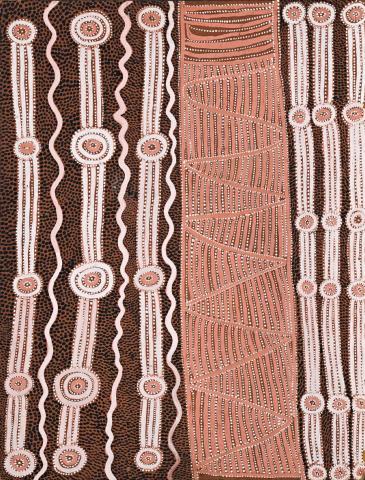TINGARI CYCLE DREAMING JOURNEY, 1972
MICK NAMARARI TJAPALTJARRI
synthetic polymer powder paint and PVA on composition board
70.0 x 42.0 cm
inscribed verso: MICK / MNS3-78
Aboriginal Fine Arts, Sydney
Acquired from the above c.1978
Private collection, New South Wales
Bardon, G. and Bardon, J., Papunya, A Place Made After The Story, The Beginnings of the Western Desert Painting Movement, Melbourne University Publishing, 2004, p. 235, which states: “This is a very long journey lesson given by the Old People and is all about gathering bush tucker. The straight lines are the travelling, the concentric circles are the special places where they rest or gather food and the central pattern depicts the foraging for bush tucker in the apparent wilderness. The people are implied.”
For a discussion of the Travelling Dreamings theme see Bardon and Bardon, 2004, pp. 50-51, for further discussion on My Country (Homeland) Dreamings see ibid p. 54 and p. 62 (map 9) for a detailed map of the artist's country (homeland), pp. 232-233 for examples of early works by the artist.
Described as a reserved man, Mick Namarari could also be characterised as an innovator whose impact on the Western Desert movement is only now starting to be fully comprehended. The breadth and scope of his ability, maintained with singular dedication over a painting career which spanned 27 years, is such that his work is considered to have ‘...transformed Papunya Tula art, heralding the ethereal minimalism of the late 1980s and1990s… Up until he passed away in 1998, Mick Namarari was still quietly revolutionising the genre...’1
Mick Namarari's works are loaded with symbolism which is closely tied to narrative, a dense and tightly coded abstraction which elegantly refers to his key stories in ever greater loops. Western Desert painting operates in the space between ceremony and country, referencing each whilst exploring ancestral inheritance. Namarari developed a visual language which was bound by cultural protocol but never restrained by it.
The artist was born in sandhill country at Marnpi Rockhole located south-west of the MountRennie Bore. After the death of both his parents Tjapaltajarri and his sister were looked after by other members of the family. Namarari attended school at the Hermannsburg mission until he was eleven years old, and was initiated in the Areyonga region, eventually working in the cattle industry. He adopted the middle name “Namarari” after his employer MacNamara, though it also expressed similarities to one of Namarari's totems, the mallee fowl.
Tjapaltjarri was one of the founding members at Papunya Tula Artists and served as a councillor on the Papunya Council. In 1991 he was awarded the National Aboriginal Art Award, a moment which heralded not only public attention for the Papunya Tula artists, but also confirmed the importance of his practice within the community. In 1994 Namarari was the recipient of the Australia Council's emeritus award for Indigenous artists and was joint winner of the Red Ochre Award.
This work, dated from the second year of the Papunya painting movement, is executed on composition board. A year earlier, Namarari, under the encouragement of Geoffrey Bardon, had begun painting his designs on discarded pieces of composition board with other Painting Men at Papunya. The painting is a gracefully controlled rendition of the classic Tingari template of linked concentric circles. Symbolising the journeys of ancestral men and women whose acts may only be known by a select few, the composition is one of the keystones of the Western Desert painters.
1 Perkins, H., and Fink, H., Genesis and Genius: The Art of Papunya Tula Artists in One Sun, One Moon, Aboriginal Art in Australia, Art Gallery of New South Wales, Sydney, 2007, p. 184
